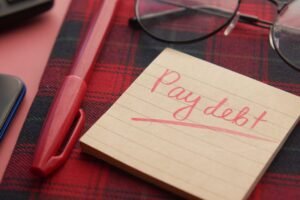How to take on debt

If you want to achieve financial freedom, one of the most important steps you need to take is getting out of debt. Debt is like a heavy burden that weighs you down and prevents you from reaching your goals. It also costs you money in interest and fees, which could be better used for saving and investing. In this article, we will share with you some practical tips on how to get out of debt and stay out of debt for good. You also might be interested in our article called How to Set Financial Goals and The Benefits of Having Them.
What is the first step?
The first thing you need to do is to assess your current debt situation. How much do you owe, and to whom? What are the interest rates and minimum payments for each debt? How long will it take you to pay off each debt if you only make the minimum payments? You can use a debt calculator or a spreadsheet to help you with this task. Once you have a clear picture of your debt, you can prioritize which debts to pay off first.
Can an emergency fund help?
After you get a clear picture of your debt, the next thing you want to do is start an emergency fund. If you already have money in savings, then great you are already on your way. Start with a mini emergency fund. Save $1,000 as a buffer for those surprise expenses. Once you have your mini emergency fund in place then move onto paying off your debit. After paying off all debit except for your mortgage, then you will save for a fully funded emergency fund. You also might be interested in our article called How to Start an Emergency Fund and Thier Role in Building Wealth.
What is a good approach to get out of debt?
If you’re struggling with debt and looking for a way to get out of it, you might want to consider the debt snowball method. This is a debt-reduction strategy where you pay off your debts from smallest to largest, regardless of the interest rate. Here’s how it works and why it can help you become debt-free faster.
How the Debt Snowball Method Works
The debt snowball method is based on the idea that paying off small debts quickly can give you the motivation and momentum to tackle larger debts. Here are the steps to follow:
- List your debts from smallest to largest balance, ignoring the interest rate. For example, if you have a $500 credit card debt, a $2,000 car loan and a $10,000 student loan, you will list them in that order.
- Make the minimum payments on all your debts except the smallest one. For the smallest debt, pay as much as you can afford every month until it’s gone. For example, if you can pay $200 a month on your $500 credit card debt, you would pay it off in three months.
- Once you pay off the smallest debt, take the money you were paying on that debt and add it to the minimum payment on the next smallest debt. This way, you create a “snowball” effect where your payments get bigger as you move up the list. For example, if you were paying $200 on your credit card debt and $2,000 on your car loan, you would now pay $2,200 on your car loan until it’s paid off.
- Repeat this process until you pay off all your debts. As you pay off each debt, celebrate your progress and keep going. You’ll see your debt-free date getting closer and closer.
Why It’s Best Not to Focus on Higher Interest Rates First
You might be wondering why you shouldn’t pay off the debts with the highest interest rates first, since they cost you more money in the long run. This is called the debt avalanche method, and it makes sense mathematically. However, personal finance is not just about math; it’s also about psychology and behavior. If we are being honest, we would not be in debt if we were doing math in the first place.
Why the debt snowball method is so effective?
The debt snowball method works because it gives you quick wins and positive feedback. When you pay off a small debt, you feel a sense of accomplishment and satisfaction. This boosts your confidence and motivation to keep going. You also free up some cash flow that you can use for other expenses or savings. The amount of interest that you pay in this process will be nothing compared to the satisfaction that you will have when you accomplish paying off your first debt and then your second or third and so on.
Don’t look too much at interest rates.
If you focus on the debts with the highest interest rates first, you might not see any progress for a long time. This can make you feel frustrated and discouraged. You might lose sight of your goal and give up. You also might not have enough money to cover your other bills or emergencies.
How can we speed up debt repayment?

One of the best ways to speed up your debt repayment is to make extra income. There are many opportunities to earn money online or offline, depending on your skills, interests, and availability. For example, you can sell unwanted items on eBay or Craigslist, take online surveys or do microtasks on sites like Swagbucks or Amazon Mechanical Turk, offer your services as a freelancer or consultant on platforms like Upwork or Fiverr, or start a blog or a podcast and monetize it with ads or sponsorships. The more money you can make, the more money you can put towards your debt.
Look at discretionary spending.
You may also want to cut back on discretionary spending. Discretionary spending is the money you spend on things that are not essential, such as eating out, entertainment, clothing, etc. While these things can make life more enjoyable, they can also drain your budget. You can save a lot of money by reducing or eliminating these expenses. For example, you can cook at home instead of ordering takeout, watch movies on a streaming service instead of going to the cinema, or shop at thrift stores instead of buying new clothes.
Negotiate your bills.
Negotiating your bills is another way to save money and is to lower your fixed expenses, such as rent, utilities, insurance, etc. You can do this by negotiating with your providers for better rates or discounts. You can also compare prices and switch to cheaper alternatives if possible. For example, you can switch to a cheaper cell phone plan, use less electricity or water, or shop around for cheaper car insurance.
Stop investing.
Lastly, stop all investing unless your employer offers a 401k or HSA match. Your employer’s match is free money, so we don’t want to leave that on the table. Invest the minimum needed to get your employer’s full match. All other investment should be paused until all the debt is cleaned up. Don’t misunderstand here, leave any retirement savings in place just stop contributing to them temporarily.
Investing will happen at a later time.
If you have debt, then you do not have enough money to be an investor now. Investing will come later in your journey. Think about it, if you have no debt, you will have so much more to invest later. You will be able to achieve more later than you ever could today when you have debt to fight with.
Final thoughts
An article on moneygeek.com named 12 Ways to Get Out of Debt Faster states: “The key to staying motivated to get out of debt faster is to mark your progress. Keep a chart and see if you can speed up the process. Celebrate when you reach payoff milestones.”
The bottom line is paying off small debts first helps you stay on track and stick to your plan, so use the debt snowball method. Getting out of debt is not easy, but it is essential to building wealth. By following these tips, you can free yourself from the shackles of debt and start living the life you deserve.
You also might be interested in our article called 3 Tips to Stop Living Paycheck to Paycheck.




